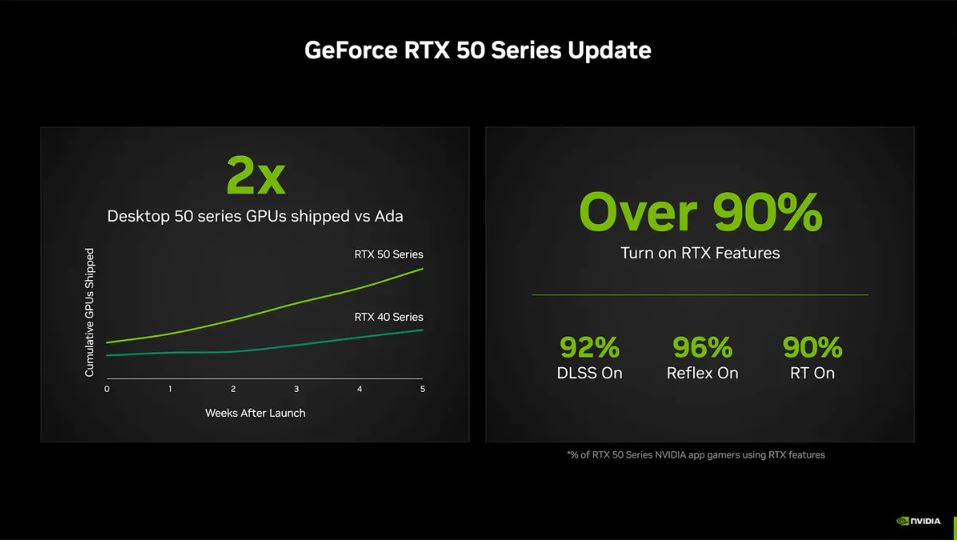Nvidia: Over 90% of RTX 50 Series Users Use DLSS
The Dominance of DLSS in the RTX 50 Series Era
The rapid advancement of Nvidia’s Deep Learning Super Sampling (DLSS) technology has revolutionized gaming graphics, delivering unmatched performance gains while maintaining superior visual fidelity. With the release of the RTX 50 Series, Nvidia has once again set a new industry benchmark, reporting that over 90% of RTX 50 Series users enable DLSS to enhance their gaming experience. This statistic underscores the indispensable role that AI-powered upscaling plays in modern gaming, driving not just smoother gameplay but also increased accessibility to 4K and high-frame-rate gaming without the need for excessive hardware upgrades.

What is DLSS and Why is it Essential for the RTX 50 Series?
DLSS, or Deep Learning Super Sampling, is a pioneering technology developed by Nvidia that utilizes AI-driven neural networks to upscale lower-resolution images in real-time. By reconstructing frames with greater detail and sharpness, DLSS enables gamers to experience stunning high-resolution visuals while benefiting from dramatically increased frames per second (FPS).
With the release of the RTX 50 Series, Nvidia introduced DLSS 4, the latest iteration of its upscaling technology. DLSS 4 leverages advanced AI models to generate additional frames, effectively boosting gaming performance up to 8 times compared to native rendering. This innovation allows players to enjoy visually intensive games like Cyberpunk 2077, Alan Wake 2, and Black Myth: Wukong at ultra settings without compromising performance.
The Astonishing Adoption Rate of DLSS Among RTX 50 Series Users
The overwhelming 90% adoption rate of DLSS among RTX 50 Series users highlights its effectiveness in delivering both performance and quality improvements. This widespread usage can be attributed to several key factors:
1. Unparalleled Performance Boosts
DLSS significantly reduces the GPU workload by rendering frames at a lower resolution and then intelligently upscaling them to higher resolutions. This results in higher FPS, making gaming at 1440p, 4K, and even 8K resolutions more feasible, even on demanding titles.
2. AI-Powered Frame Generation
One of the standout features of DLSS 4 is its multi-frame generation capability. Unlike previous versions, which relied on traditional upscaling techniques, DLSS 4 can generate up to three additional frames per rendered frame, effectively quadrupling performance in some cases. This means games appear smoother and more fluid, reducing input lag and screen tearing, which are critical factors for competitive gamers.
3. Enhanced Image Quality with AI Supersampling
DLSS employs advanced AI models to reconstruct high-resolution images that often surpass native rendering in sharpness and clarity. This is especially noticeable in games with ray tracing, where traditional rendering methods struggle to maintain high frame rates. By intelligently enhancing textures, shadows, and reflections, DLSS 4 ensures that visual quality remains uncompromised.
4. Reduced Hardware Requirements
For many gamers, upgrading to the latest GPUs can be cost-prohibitive. DLSS provides a cost-effective solution by enabling older GPUs to deliver next-gen performance levels. By allowing RTX 50 Series GPUs to run at significantly higher FPS rates while maintaining high-quality visuals, DLSS extends the longevity of gaming hardware and maximizes value for users.
How DLSS is Shaping the Future of PC Gaming
As gaming technology continues to evolve, the role of AI-driven upscaling like DLSS is becoming increasingly critical. With major game developers integrating DLSS 4 support into upcoming AAA titles, we are witnessing a shift toward AI-enhanced rendering as a standard feature in modern gaming.
Widespread Game Developer Adoption
Industry leaders such as CD Projekt Red, Bethesda, and Ubisoft have embraced DLSS technology in their game engines, ensuring that upcoming releases leverage its full potential. Nvidia’s partnerships with game studios continue to expand, making DLSS support more prevalent across various gaming platforms.
Ray Tracing and DLSS: A Perfect Combination
One of the biggest challenges of implementing real-time ray tracing has been the computational cost. However, with DLSS 4, games can now deliver cinematic-quality lighting effects while maintaining high frame rates. This synergy between ray tracing and DLSS is shaping the future of gaming graphics, allowing developers to push the boundaries of visual realism.
Expanding Beyond Gaming: DLSS in Content Creation and AI Workloads
While primarily designed for gaming, DLSS has found applications in content creation and AI-powered workflows. Game developers, 3D artists, and video editors benefit from faster rendering times and improved AI-driven enhancements, demonstrating that DLSS technology is not limited to gaming alone.
Challenges and Concerns: Is DLSS the Future or a Temporary Solution?
While DLSS 4’s adoption rate is impressive, some concerns remain regarding its long-term impact on game development and performance optimization.
1. Developers Relying Too Heavily on DLSS
With the increasing dependence on AI-driven upscaling, some critics argue that game developers may become less incentivized to optimize native rendering performance. Instead of fine-tuning game engines for efficiency, studios might rely on DLSS to compensate for unoptimized graphics.
2. Input Lag and Motion Artifacts
Although DLSS 4’s frame generation technology drastically improves performance, it introduces some trade-offs, such as slight input lag and occasional motion artifacts. Competitive gamers who require the lowest latency possible may find this a limiting factor in high-speed FPS and esports titles.
3. Compatibility and Hardware Requirements
Despite its advantages, DLSS is exclusive to Nvidia’s RTX GPUs, meaning users with older GTX or AMD Radeon cards cannot benefit from this technology. This creates a barrier for gamers who have yet to upgrade to RTX-powered hardware.
Conclusion: DLSS and the Unstoppable Rise of AI in Gaming
The fact that over 90% of RTX 50 Series users enable DLSS is a testament to the technology’s game-changing impact on performance and visual quality. As Nvidia continues to refine DLSS 4 and beyond, we can expect further breakthroughs in AI-powered rendering, frame generation, and real-time upscaling.
With industry-wide adoption and ongoing improvements, DLSS is not just a feature—it’s a necessity for modern PC gaming. Whether you’re an enthusiast craving ultra-realistic graphics or a competitive player demanding high FPS with minimal input lag, DLSS delivers an unparalleled gaming experience that sets new standards in the world of GPU technology.
As gaming evolves, DLSS will continue to push boundaries, ensuring that high-performance, high-fidelity gaming is accessible to all.





















